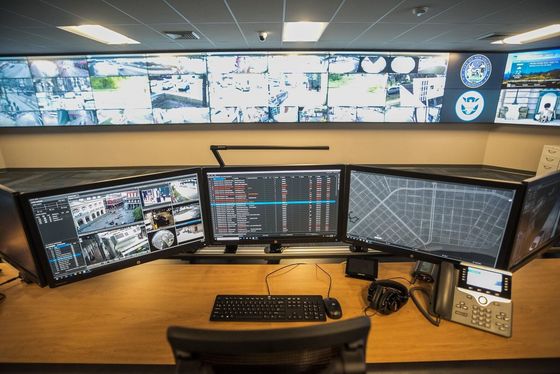In a stern warning to the New Orleans City Council, the city’s top police watchdog has criticized a plan to expand surveillance without also expanding oversight. The Office of Independent Police Monitor (OIPM) warned that the city is on a path that may lead to abuse, racial discrimination, and fiscal waste.

New Orleans Real Time Crime Monitoring Center (Source: Nola.gov)
In November, New Orleans Mayor Mitch Landrieu announced a $5-million “Real Time Crime Monitoring Center” near the French Quarter that would allow for 24-7 monitoring of both private and government-owned CCTV cameras, automated license plate readers (ALPRs), and other advanced surveillance technology. The facility coincides with a plan to install 250 new surveillance cameras and 106 new ALPRs in 2018.
The plan was also criticized by the Music & Culture Coalition of New Orleans [.pdf], which represents the Big Easy’s vibrant art and music scene, as “poorly conceived, reactionary, and intentionally ambiguous.” The group complained that the lack of a public process resulted in the creation of “a blueprint for unconstitutional surveillance.”
In response to community concerns, Acting Police Monitor Ursula Price wrote in a letter that the systems “have the potential to jeopardize the expensive and hard-won police reforms of the past ten years.” She notes that despite earmarking millions for expanded surveillance, the city has not proportionately increased funding for oversight and monitoring to prevent abuse. Drawing from case studies in London, Chicago, and San Francisco, and EFF’s own work in the New Orleans area, she shows that surveillance has historically violated the privacy of constituents, particularly women and communities of color. She predicts the technologies may create civil liability for the city without positively impacting public safety, especially considering the cybersecurity risks associated with large-scale storage of personal data.
OIPM recommended seven key reforms:
- Prohibit magnification of an individual’s face without reasonable suspicion or threat to public safety and monitor compliance.
- Prohibit aiming the camera at an individual’s or group's activity without reasonable suspicion or threat to public safety and monitor compliance.
- Require camera operators to adhere to the same 4th Amendment-informed NOPD [New Orleans Police Department] policies regarding reasonable suspicion and monitor compliance.
- Prohibit pointing cameras into private homes and monitor compliance.
- Balance the need for public information against public privacy when setting rules on dissemination and duration of image retention and monitor compliance.
- Monitor NOPD to ensure consistent enforcement of camera policies and discipline those who violate policy.
- Private cameras linked to the command center feeds must follow the same rules and regulations as public cameras.
Independent and civilian oversight bodies in other cities should take a cue from New Orleans’ OIPM and, in their own communities, begin analyzing the policies governing the use of these spying technologies and investigate how law enforcement abuses surveillance.
Watchdog bodies should start with EFF’s “Law Enforcement Technology Primer for Civilian Oversight Bodies,” [.pdf] a guide developed in 2015 for the National Association for Civilian Oversight of Law Enforcement. The paper outlines the emerging civil liberties issues presented by new technologies, what questions oversight bodies should ask, and what actions can be taken to protect the public from unrestrained surveillance.
For more information on surveillance technologies used by local police department, such as ALRPs, body-worn cameras, cell-site simulators, drones, and face recognition, visit EFF’s Street-Level Surveillance project.












